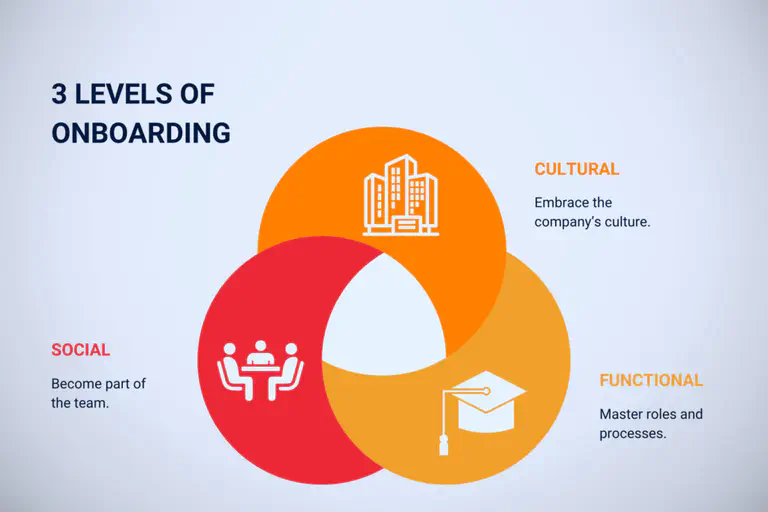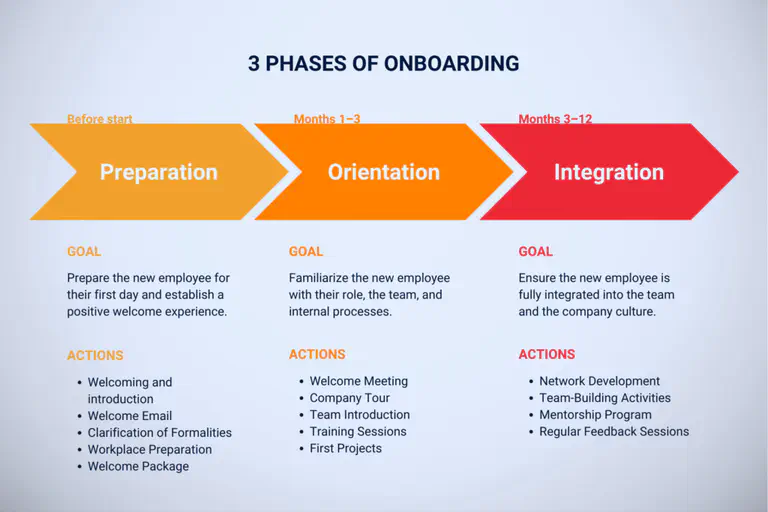Optimize your onboarding process #
The vacancy has finally been filled and the onboarding process for your new employee begins. Nervousness is inevitable, especially on the part of the employee. But you and the HR department are also confronted with special circumstances with every new hire and naturally want the employee onboarding to go smoothly. For you, this means initiating all the necessary processes in good time.
Onboarding management refers to the systematic induction and integration of new employees into a company. The aim of an onboarding concept is to give your new employees a good start in your company and to integrate them into your corporate structure both professionally and culturally and socially.
Why a structured onboarding concept is important #
Structured onboarding of new employees is of central importance for the success and long-term development of your company. It helps your new employees achieve their full potential faster by introducing them safely to their new tasks. Targeted induction and support makes them feel competent and productive, which quickly boosts their performance.
In addition, a well-organized onboarding program helps to keep your employees in the company in the long term. This is because employees who feel well integrated and supported from the outset are more likely to remain loyal to your company. This reduces turnover and ensures that valuable knowledge and experience is retained in your company.

Structured onboarding management also promotes the motivation and satisfaction of new employees. If they clearly understand what you expect of them and how they can contribute to the success of the company, their job satisfaction increases considerably. In addition, well-trained employees are happy to contribute their knowledge internally and are willing to develop themselves further. This creates a culture of continuous learning and knowledge sharing.
Finally, satisfied and well-trained employees are happy to recommend their company as an attractive employer. Positive word of mouth and good reviews on platforms such as Kununu or Glassdoor help to strengthen your employer image and attract new talent.
The 3 levels of onboarding #
Structured onboarding of new employees comprises three key levels: professional, social and cultural integration. Each of these levels plays a crucial role in successfully and comprehensively integrating new employees into your company.
Professional integration #
Professional integration focuses on providing the necessary knowledge and skills that your new employee needs for their specific role. This includes training, familiarization with work processes and systems, and introduction to tasks and responsibilities. The aim is to give your new employee the tools they need to carry out their work competently and efficiently. Thorough professional integration ensures that they quickly become productive and feel confident in their new area of responsibility.
Social integration #
Social integration is designed to integrate your new employee into the social fabric of your organization. This includes fostering social contacts and building relationships with colleagues and superiors. Activities such as team meetings, informal get-togethers and team-building activities play an important role here. Through social integration, your new employee will quickly feel part of the team, which increases their well-being and retention. A strong social network within the company also offers support with questions and challenges.
Cultural integration #
Cultural integration aims to familiarize your new employees with the goals, principles and culture of your company. This includes communicating your mission, vision and values as well as the ethical and cultural norms that shape your company’s daily activities. As a result, your new employees will not only understand what behavior is expected of them, but also why these expectations are important and how they contribute to achieving the company’s goals. This promotes a deeper identification with the company and strengthens the loyalty of your employees.

The 3 phases in onboarding management #
According to a study, a new employee usually needs eight months to be fully productive. Within this time, onboarding management comprises three stages: the preparation phase, the orientation phase and the integration phase.
1. Preparation phase #
The preparation phase, also known as preboarding, begins with the signing of the contract and ends on the first day of work. The aim of this phase is to give your new employee the feeling that they are starting with a professional employer who takes care of its employees. During this phase, you send them important information, clarify any unanswered questions and draw up an induction plan. You also ensure that the workplace is equipped with all the necessary work equipment. Important preparations that you should make in the course of this are
- Clarification of formalities
- Coordination of appointments
- Providing information
- Involving colleagues
- Preparation of the workplace
- Organization of employee training
- Definition of responsibilities
- Putting together a welcome pack
2. Orientation phase #
The orientation phase starts on the first day of work and lasts for the first three months. During this phase, you introduce your new employee to their role and tasks in the company. They will get to know the company, its processes, colleagues, customers and superiors. To make this phase as pleasant as possible, you should bear the following points in mind:
- Welcome and introduction to the team
- Introduction to work equipment and IT systems
- Clarification of mutual expectations
- Assignment of initial tasks
- Clarification of legal aspects
- Social insurance and benefits
- Company tour
- Presentation of the products
- Communication of corporate goals and values
3. Integration phase #
This phase of onboarding extends from the third to the sixth, sometimes even up to the twelfth month. The main focus during this time is on integrating your new employee more and more into the company. In order to encourage this, you should allow your employee to take the initiative on as many occasions as possible and let them implement their own ideas.
- Joint events
- Workshops and information days
- Regular feedback meetings
- Provision of follow-up information
- Strengthening the team spirit
- Promotion of contacts and networking

Feedback and evaluation in the onboarding process #
Regular feedback is crucial for the continuous improvement of your onboarding process. To ensure that the integration of new employees is successful, you and your managers should schedule fixed dates in advance for feedback meetings. These meetings should take place at regular intervals to get a comprehensive picture of your new employee’s experience.
By systematically collecting and evaluating this feedback, your company can identify weaknesses in the onboarding process in order to make targeted improvements.
7 tips for a successful onboarding process #
Successful onboarding of new employees lays the foundation for a positive, productive and long-term collaboration. First impressions count when welcoming new employees and introducing them to your company’s culture and way of working. For this reason, it is important to pay particular attention to a few key aspects.

1. Create an onboarding concept #
Develop a comprehensive onboarding concept that defines clear goals and expectations. Integrate detailed checklists to ensure that all steps are carried out systematically and efficiently.
2. Allow for lead times #
Allow sufficient lead time to complete all necessary preparations before your new employee’s first day at work. Take into account the processing times for all relevant documents and internal processes.
3. Plan joint events #
Organize team-building events and other joint activities to promote the integration of new employees and create a positive working atmosphere. This helps new hires to quickly feel at home and get to know the company culture during onboarding.
4. Obtain legal documents and personnel data in good time #
Request all necessary legal documents and personnel data in good time. This includes the employment contract, tax information, proof of insurance and other relevant documents. Make sure that these are complete and correct before the first day of work.
5. Continuously optimize the process #
Review and improve the onboarding process regularly. Collect feedback from your new employees and managers to identify weaknesses and continuously optimize the process.
6. Onboarding and offboarding #
Pay attention to the subsequent offboarding process during onboarding management. A well-structured onboarding concept is important, but it is just as crucial to clearly define from the outset what needs to be considered when an employee leaves. Document all relevant steps so that nothing is forgotten if the worst comes to the worst.
7. Use good software #
Use a suitable onboarding program to maintain an overview and make the process efficient. A good software solution should offer onboarding and offboarding checklists, reminders and the management of all relevant documents and information.
The right onboarding program for your requirements #
With SeaTable’s free template, you can design your onboarding process so efficiently that you not only relieve your HR processes , but also make it as easy as possible for your new employees to get started.
With just one click, you can create an intuitive checklist with all upcoming tasks for each new employee, so that everyone knows exactly what needs to be done. To avoid chaos and paperwork, you can store all important documents directly in the spreadsheet and have them digitally signed.
In the free template from SeaTable, you can bundle all tasks and information in one place. By assigning clear responsibilities as well as a time horizon and status to each to-do, you can clearly visualize the progress of the training and track it live.
Rely on suitable software and ensure that your new employees feel immediately welcome and quickly settle into your company. To use the no-code platform SeaTable , all you need to do is register free of charge. You can then add the template to your base and complete it with your own data.
Frequently asked questions #
Why is a structured onboarding process important?
What should be included in a good onboarding concept?
How can I optimize the onboarding process for new employees?
What are the phases of a typical onboarding process?
A typical onboarding process consists of:
- Preparation phase (preboarding): Contract signing until the first working day.
- Orientation phase: First three months in the company.
- Integration phase: Three to twelve months after starting.
Each phase focuses on different tasks and objectives, e.g. organizational preparation, introduction and long-term integration.
What are the advantages of using software in the onboarding process?
